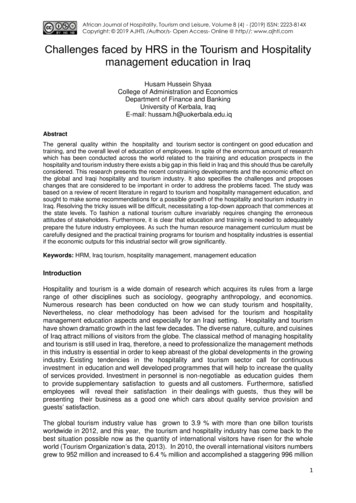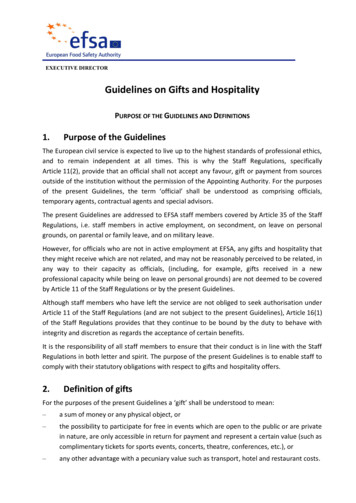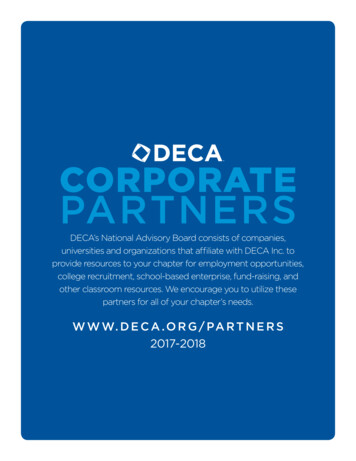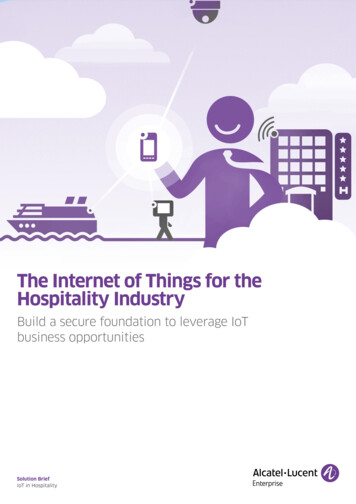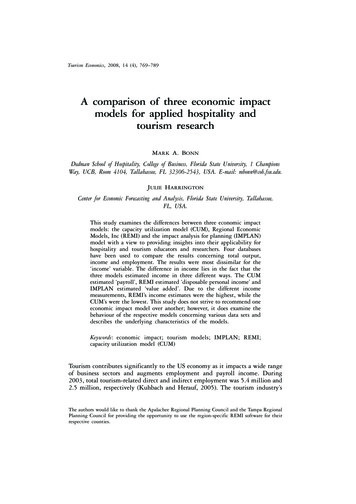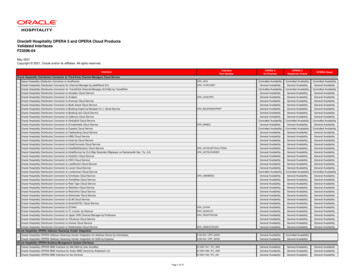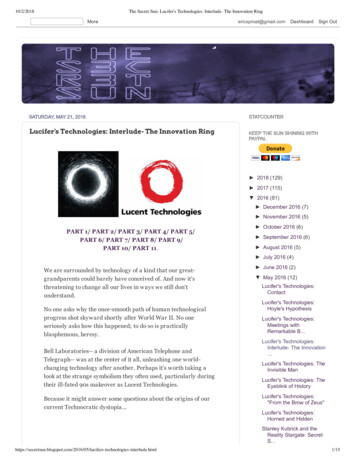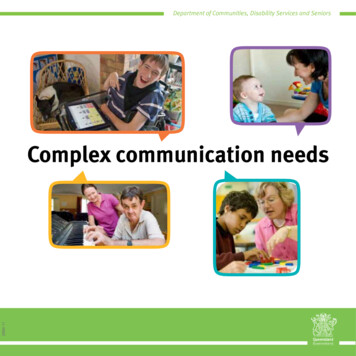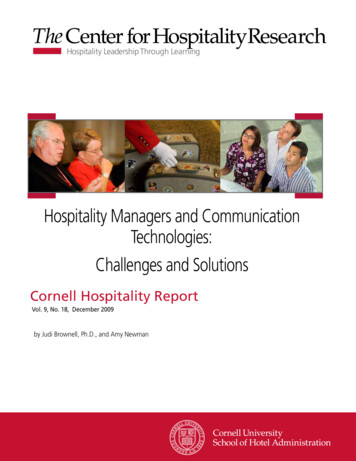
Transcription
Hospitality Managers and CommunicationTechnologies:Challenges and SolutionsCornell Hospitality ReportVol. 9, No. 18, December 2009by Judi Brownell, Ph.D., and Amy Newmanwww.chr.cornell.edu
Advisory BoardRa’anan Ben-Zur, CEO, French Quarter Holdings, Inc.Scott Berman, U.S. Advisory Leader, Hospitality and LeisureConsulting Group of PricewaterhouseCoopersRaymond Bickson, Managing Director and Chief ExecutiveOfficer, Taj Group of Hotels, Resorts, and PalacesStephen C. Brandman, Co-Owner, Thompson Hotels, Inc.Raj Chandnani, Vice President, Director of Strategy, WATGBenjamin J. “Patrick” Denihan, CEO,Denihan Hospitality GroupMichael S. Egan, Chairman and Founder, job.travelJoel M. Eisemann, Executive Vice President, Owner andFranchise Services, Marriott International, Inc.Kurt Ekert, Chief Operating Officer, GTA by TravelportBrian Ferguson, Vice President, Supply Strategy and Analysis,Expedia North AmericaKevin Fitzpatrick, President,AIG Global Real Estate Investment Corp.Gregg Gilman, Partner, Co-Chair, Employment Practices,Davis & Gilbert LLPSusan Helstab, EVP Corporate Marketing,Four Seasons Hotels and ResortsJeffrey A. Horwitz, Partner, Corporate Department,Co-Head, Lodging and Gaming, Proskauer Rose LLPKenneth Kahn, President/Owner, LRP PublicationsPaul Kanavos, Founding Partner, Chairman, and CEO, FX RealEstate and EntertainmentKirk Kinsell, President of Europe, Middle East, and Africa,InterContinental Hotels GroupNancy Knipp, President and Managing Director,American Airlines Admirals ClubRadhika Kulkarni, Ph.D., VP of Advanced Analytics R&D,SAS InstituteGerald Lawless, Executive Chairman, Jumeirah GroupMark V. Lomanno, President, Smith Travel ResearchSuzanne R. Mellen, Managing Director, HVSDavid Meltzer, Vice President, Sales, SynXis CorporationEric Niccolls, Vice President/GSM, Wine Division,Southern Wine and Spirits of New YorkShane O’Flaherty, President and CEO, Forbes Travel GuideTom Parham, President and General Manager,Philips Hospitality AmericasChris Proulx, CEO, eCornell & Executive EducationCarolyn D. Richmond, Partner and Co-Chair, HospitalityPractice, Fox Rothschild LLPSteve Russell, Chief People Officer, Senior VP, HumanResources, McDonald’s USASaverio Scheri III, Managing Director,WhiteSand ConsultingJanice L. Schnabel, Managing Director and Gaming PracticeLeader, Marsh’s Hospitality and Gaming PracticeTrip Schneck, President and Co-Founder, TIG Global LLCAdam Weissenberg, Vice Chairman, and U.S. Tourism,Hospitality & Leisure Leader, Deloitte & Touche USA LLPThe Robert A. and Jan M. Beck Center at Cornell UniversityBack cover photo by permission of The Cornellian and Jeff Wang.Cornell Hospitality Reports,Vol. 9 No. 18 (December 2009) 2009 Cornell UniversityCornell Hospitality Report is produced forthe benefit of the hospitality industry byThe Center for Hospitality Research atCornell UniversityRohit Verma, Executive DirectorJennifer Macera, Associate DirectorGlenn Withiam, Director of PublicationsCenter for Hospitality ResearchCornell UniversitySchool of Hotel Administration537 Statler HallIthaca, NY 14853Phone: 607-255-9780Fax: 607-254-2292www.chr.cornell.edu
Senior PartnersThank you to ourgenerousCorporate MembersAmerican Airlines Admirals Clubjob.travelMcDonald’s USAPhilips HospitalitySouthern Wine and Spirits of New YorkTaj Hotels Resorts PalacesTIG Global LLCPartnersAIG Global Real Estate InvestmentDavis & Gilbert LLPDeloitte & Touche USA LLPDenihan Hospitality GroupeCornell & Executive EducationExpedia, Inc.Forbes Travel GuideFour Seasons Hotels and ResortsFox Rothschild LLPFrench Quarter Holdings, Inc.FX Real Estate and Entertainment, Inc.HVSInterContinental Hotels GroupJumeirah GroupLRP PublicationsMarriott International, Inc.Marsh’s Hospitality PracticePricewaterhouseCoopersProskauer Rose LLPSASSchneider ElectricSmith Travel ResearchSynXis, a Sabre Holdings CompanyThayer Lodging GroupThompson Hotels GroupTravelportWATGWhiteSand ConsultingFriendsAmerican Tescor LLC Argyle Executive Forum Berkshire Healthcare Cody Kramer Imports Cruise Industry News DK Shifflet & Associates ehotelier.com EyeforTravel 4Hoteliers.com Gerencia de Hoteles & Restaurantes Global Hospitality Resources Hospitality Financialand Technological Professionals hospitalityInside.com hospitalitynet.org Hospitality Technology Hotel Asia Pacific Hotel China HotelExecutive.com Hotel Interactive Hotel Resource HotelWorld Network International CHRIE International Hotel Conference International Society of Hospitality Consultants iPerceptions JDA Software Group Lodging Hospitality Lodging Magazine MilestoneInternet Marketing MindFolio Mindshare Technologies Parasol PhoCusWright PKF Hospitality Research RealShare Hotel Investment &Finance Summit Resort Recreation Magazine The Resort Trades RestaurantEdge.com Shibata Publishing Co. Synovate The LodgingConference TravelCLICK UniFocus WageWatch, Inc. WIWIH.COM
Hospitality Managersand CommunicationTechnologies:Challenges and Solutionsby Judi Brownell and Amy NewmanAbout the AuthorsJudi Brownell, Ph.D., is a professor of organizational communication and Dean of Students at the School of Hotel Administration (jlb18@cornell.edu). Her research projects include studies on managerial listening behavior and the competencies required for global hospitalityleaders. She has created tools to assess employee-organization fit and the communication of service values. Hercurrent research focuses on listening as it relates to communicating and maintaining service quality standards in theinternational cruise industry. She is the author of several textbooks, has published over 80 articles, and serves onseveral editorial boards. She is also past president of the International Listening Association and has received awards forher research in this field. Brownell has conducted training and consulting for a wide range of hospitality organizations.Among her projects, she has designed assessment centers for hospitality leadership development. A seasonedadministrator, she has served as the school’s associate dean for academic affairs and as its director for graduate studies.Amy Newman is a lecturer of management communication at the Cornell School of Hotel Administration (an97@cornell.edu). With a primary research focus on communication technologies, she has heldmanagement positions at MCI, Canon, and Reuters, including employee relations manager,manager of career and leadership development, and director of employee development. She has also consulted withhospitality, technology, education, publishing, financial services, and entertainment companies. She works with clientsto develop strategic communication plans, learning strategies, and innovative face-to-face, print, and technologybased solutions.The authors acknowledge and thank Rebecca Daniel for her assistance in preparing this paper4The Center for Hospitality Research Cornell University
Executive SummaryAstudy on communication technologies among a convenience sample of 100 hotel managersfound that email is both pervasive and intrusive, while other new media (i.e., instantmessaging, intranets, wikis, and blogs) are only gradually gaining a foothold in the hotelindustry. Although the volume of email was a concern for these hotel managers, even morechallenging was the issue of ensuring that messages accurately conveyed both information and emotion.Respondents disagreed somewhat on how quickly one should respond to an email. While most thoughta 24-hour turnaround was acceptable, others were willing to let matters slide longer—potentiallyincurring dissatisfaction from customers and coworkers. Even in such a small sample, respondentsshowed divergent attitudes toward the technologies based on their age, gender, and native language.For example, as compared to men, women were particularly unhappy with poor grammar andpunctuation in emails they received. Young respondents differed considerably from older respondentson the challenge of clarity in received emails, and those for whom English was a second language weremost concerned that they could send clear, grammatical emails. Respondents could appreciate thepotential value of intranets and other new communication vehicles, but they reported littleimplementation of those technologies.Cornell Hospitality Report December 2009 www.chr.cornell.edu5
COrnell Hospitality ReportHospitality Managers andCommunication Technologies:Challenges and SolutionsEby Judi Brownell and Amy Newmanmail has become so ubiquitous that most of us cannot imagine living—or working—without it. To be sure, email absorbs much time. If, for example, you receive 50 messageseach work day and send 25, with an average of two minutes spent per email, you’respending 75 days each year on email.1 Despite people’s heavy use of email, we must noteits inherent weaknesses. First, all that time spent does not make users more competent communicatorsor more confident that they have sent an appropriate message. More to the point, hospitality employees,much like their counterparts in other industries, struggle with managing large numbers of messages,understanding what senders really mean, and getting their point across—while striving to maintainpositive working relationships with colleagues, customers, and the public. Similarly, relatedcommunication technologies, such as instant messaging (IM), intranets, document-sharing, wikis,social networking sites, and blogs provide both opportunities and challenges for how we communicateat work. While many of the challenges brought about by these technologies are universal, the hospitalityindustry is distinguished by its need to manage guest relationships and expectations without the benefitof face-to-face contact. Every interaction provides an opportunity to build a customer relationship andthereby attract future business.1 A calculation first suggested in: M. Song, V. Halsey, and T. Burress, The Hamster Revolution (San Francisco: Berrett-Kohler Publishers, 2007).6The Center for Hospitality Research Cornell University
Focusing on the use of communication technologies byhotel managers, this report addresses the following questions: How much time do hospitality managers spend onemail? What challenges do they confront in sending andreceiving messages? Are hospitality managers taking advantage of emerging technologies to accomplish their communication goals?We first review related studies on the use of email andother communication technologies in business environments. We then summarize the results of a convenience survey of hospitality managers that explored the nature of theirdaily practices and sought to identify the challenges theyconfront. After presenting these findings, we provide recommendations to managers who want to improve their businesscommunication effectiveness through more informed use oftechnologies at work. We suggest that managers can benefitfrom a better understanding not only of email protocol, butof the potential that other emerging communication technologies offer for improving effectiveness in the hospitalityworkplace.Studies of EmailEmail has become a standard form of business communication. A 2006 survey of 150 senior executives found that,over the previous five-year period, email had replaced thetelephone as the method of communication used mostfrequently at work. Over 70 percent of respondents selectedCornell Hospitality Report December 2009 www.chr.cornell.eduemail as their most frequent communication channel, withonly 14 percent choosing face-to-face communication.2A review of the literature regarding email challengesin the workplace tells us that email overload continues tobe one of the most significant issues.3 This overload comesnot only from the number of emails which employeesmust manage daily, but also from vaguely worded, unclearrequests and the feeling that one should respond quickly.Another frequently mentioned concern is the use of email todelegate tasks, which typically drags people into what oftenbecomes a long email chain among several parties. In a 2006study, researchers found that 56 percent of the employeeswho responded agreed that email is used too frequently instead of face-to-face communication. 4 Respondents also feltthat too many people are copied unnecessarily on messages,adding further to the perception of email overload.Several studies have focused on specific practicesrelated to email use. Employees commonly drop other tasks2 OfficeTeam, “ ‘We never talk anymore.’ Survey reveals few executivesuse telephone or meet in person at work,” January 18, 2006, retrieved onJuly 29, 2009, from www.officeteam.com/PressRoom?id 1601.3 G.F. Thomas and C.L. King, “Reconceptualizing E-mail Overload,”Journal of Business and Technical Communication, Vol. 20 (2006), pp.252-287.4 T.W. Jackson, A. Burgess, and J. Edwards, “A Simple Approach toImproving Email Communication,” Communications of the ACM, Vol. 49,No. 6 (June 2006), pp. 107-109.7
when they receive an email alert and immediately read (andrespond to) incoming messages—a process which, according to one study, causes 64 seconds of recovery time for eachemail.5 With numerous emails, the damage to productivityis considerable, given that employees interrupt other workso they can react to an email within six seconds, and thenneed more than a minute to return to their previous worksituation.The growing volume of legitimate and spam emailcompounds the problem. A 2009 survey reported that spamaccounted for over 90 percent of all email received.6 Evenwithout spam, business-related email is growing. Anotherstudy found a tenfold increase in the size of email archivesfrom 1996 to 2006.7 Users at this technology company hadsignificantly expanded the number folders they used forcategorizing email (an average of 133 in 2006, comparedwith 47 in 1996).Although expectations for email response time varywidely, most managers try to respond within 24 hours.8 Inone recent study, hotel guests who had sent an email complaint indicated that both their satisfaction and intention toreturn to the hotel were related to the time it took the hotelto respond to their questions. Reported customer satisfaction and return intent dropped steadily within the first 24hours and then again after a week of non-response. In thisstudy, 60 percent of guests waited longer than 48 hours for aresponse.9Another study noted the key role of subject lines, finding that 35 percent of users open messages because of whatis in the subject line.10 Most subject lines contain from 8 to47 characters. Longer lines were found to be less effectiveunless the sender was attempting to reach highly targetedaudiences.Determining the intended tone of emails is another ongoing issue that managers regularly confront. Without vocalor other nonverbal cues, employees struggle to understandthe true meaning of emails and often misinterpret messages.11In fact, one study found that receivers often misinterpretwork emails as having a more negative tone than the authorintended. Characteristics of both the sender and receiver,including gender, status, age, and previous relationship, influence the way messages are interpreted.12Emails containing inappropriate content or emotion canbe disastrous. Examples of individuals and companies suffering the consequences of having sent emotional emails—angry, sarcastic, distressed—are not difficult to find.13 Complicating the situation is the fact that communicators generallybelieve that their messages are more effective than receiversperceive them to be.14 In particular, Kruger found that emailusers are overconfident in their ability to appropriately communicate emotions such as seriousness, anger, and sorrow.15One email solution to the challenge of expressing emotions is emoticons. Krohn, following his review of literatureon this subject, concludes that the use of emoticons shouldbe based on the recipient’s age category.16 His continuumbegins with Traditionalists (born before 1946) and BabyBoomers (born between 1946 and 1964), who should receivemessages without these cues. Generation Xers (born between1964 and 1980) and Millennials (born after 1980), on theother hand, expect a more generous use of emoticons in theemails they receive.Email can also be the source of public embarrassmentand discovery in litigation. Countrywide Financial Corporation and other companies have seen internal emailsdistributed on the internet—with considerable damage totheir reputations.17 According to an American Management Association study, 24 percent of companies have had5 T.W. Jackson, R. Dawson, and D. Wilson, “Understanding Email Interaction Increases Organizational Productivity,” Communications of theACM, Vol. 46, No. 8 (2003), pp. 80-84.6 L. Whitney, “Report: Spam Now 90 Percent of All E-mail,” CNET11 D. Goleman, “E-Mail Is Easy to Write (and to Misread),” The New YorkTimes, October 7, 2007, section 3, page 17; and J. Kruger, N. Epley, J.Parker, and Z. Ng, “Egocentrism over E-mail: Can We Communicate asWell as We Think?,” Journal of Personality and Social Psychology, Vol.89, No. 6 (2005), pp. 925-936.12 K. Byron, “Carrying Too Heavy a Load? The Communication and Mis-News, May 26, 2009. Retrieved on June 15, 2009, from http://news.cnet.com/8301-1009 3-10249172-83.html/.7 D. Fisher, A.J. Brush, E. Gleave, and M.A. Smith, “Revisiting Whittaker& Sidner’s ‘Email Overload’ Ten Years Later,” Microsoft Research, SSCW2006 Conference, November 4-8, 2006 (Banff, Alberta, Canada, ACMPress, 2006), pp. 309-312.8 Y.M. Kalman and S. Rafaeli, “Email Chronemics: Unobtrusive Profilingof Response Times,” Proceedings of the 38th Hawaii International Conference on System Sciences, 2005.9 A.S. Mattila and D.J. Mount, “The Impact of Selected Customer Char-acteristics and Response Time on E-complaint Satisfaction and ReturnIntent,” International Journal of Hospitality Management, Vol. 22, No. 2(2002), pp. 135-145.10 EmailStatCenter. www.emailstatcenter.com/SubjectLines.html (retrieved on July 29, 2009).8communication of Emotion by Email,” Academy of Management Journal,Vol. 33, No. 2 (2008), pp. 309-327.13 D. Shipley and W. Schwalbe, SEND: Why People Email So Badly andHow to Do It Better (New York: Alfred A. Knopf, 2008).14 Kruger et al., op. cit.)15 Ibid.16 F. Krohn, “A Generational Approach to Using Emoticons as NonverbalCommunication,” Journal of Technical Writing and Communication,Vol.34 (2004), pp. 321-328.17 E. Friedlander, “Oops! Countrywide Chairman Mozilo’s ‘Disgusting’Email,” May 21, 2008. Retrieved on June 11, 2009, from countrywide-chairman-mozilosdisgusting-email/.The Center for Hospitality Research Cornell University
email subpoenaed in lawsuits, 15 percent of companies havefought lawsuits triggered by employee email, and 26 percenthave terminated employees for misusing email.18 In addition,threats from hackers and viruses, as well as security issues,continue to plague organizations.Emerging Technologies:IM, Intranets, and Social MediaAlthough email persists as the most pervasive communication technology in most organizations, other options areemerging. Instant messaging is becoming increasinglypopular in companies, and corporate intranets are evolvingto incorporate more social media capabilities, such as wikisand blogs. A number of these options provide hospitalitymanagers with cost-effective approaches to build customerrelationships and connect employees in new ways.Research reveals evidence that IM is used not only as anadditional communication option but in preference to thetelephone, email, and face-to-face communication.19 IM users report lower levels of disruptive interruptions than nonusers.20 Employees believe that IMs provided timely, relevantinformation—at the time they choose. Multi-tasking withIM as one of several activities is common.21The 2006 AMA study mentioned above reported that 35percent of employees use IM at work, and a Gartner analystpredicts that by 2015 approximately 95 percent of employeeswill use IM as their primary communications tool for voice,video, and text chatting.22 Of those using IM at work in 2004,68 percent believed IM was positive overall, 50 percent believed it saves “some” to “a lot” of time, and 11 percent saidthey couldn’t live without it.23 The next decade is likely tobring even greater dependence on this business communication method.However, as with email, companies need to be concerned about IM security and potential liability. Fifty percent18 American Management Association and the ePolicy Institute. 2006Workplace E-mail, Instant Messaging and Blog Survey. Retrieved July 29,2009, from www.epolicyinstitute.com/survey2006Summary.pdf.19 A.F. Cameron and J. Webster, “Unintended Consequences of Emerging Communication Technologies: Instant Messaging in the Workplace,”Computers in Human Behavior, Vol. 21 (2005), pp. 85-103.20 R.K. Garrett and J.N. Danziger, “IM Interruption Management? In-stant Messaging and Disruption in the Workplace,” Journal of ComputerMediated Communication, Vol. 13, No. 1 (2007), article 2.21 E. Shiu and A. Lenhart, “How Americans Use Instant Messaging,” PewInternet & American Life Project. September 2004. Retrieved on July 29,2009, from Instant-Messaging.aspx.22 American Management Association, loc.cit.; J. Fenn et al. “Hype Cyclefor Emerging Technologies, 2008 [ID Number: G00159496]. Retrieved onMay 20, 2009, from hypeCycles.jsp.23 Shiu and Lenhart, op.cit.Cornell Hospitality Report December 2009 www.chr.cornell.eduof workplace IM users admitted downloading and installingfree IM tools from the internet,24 and 24 percent of employees admitted sending or receiving jokes, gossip, and disparaging remarks through IM.Intranets. Intranets seem well established in many corporations in the United States and other countries. Seventyone percent of 561 organizations surveyed internationally inlate 2008 and early 2009 had used an intranet for more thanfive years.25 Social media, or Intranet 2.0 tools, are now present in almost 50 percent of companies in North America,Europe, Australia, and New Zealand. For instance, 93percent of the largest companies in Finland have intranets.26The most commonly implemented Intranet 2.0 tools are discussion forums (46 percent), wikis (47 percent), and blogs(45 percent).27Despite their pervasiveness, intranets have offeredat best mixed results for companies and their employees.Seventy-four percent of respondents in the Finland studyconsidered intranets to be an important source of companyinformation.28 Despite intranets’ potential to encourageincreased employee collaboration and interaction,29 however,only 29 percent of organizations’ respondents in the Prescient Digital Media study rated functionality of new socialmedia tools as good or very good, and 24 percent rated themas poor or very poor.Wikis. A well established concept, wikis may be considered the evolution of online document-sharing and discussion forums. Today, wikis incorporate these functions andothers for a designated online community to share and create knowledge. A 2005 study of enterprise wiki users foundthat wikis made work easier and helped organizations reuseknowledge, increase collaboration efficiency, and improvework processes.30Blogs. Like wikis, blogs are one of the fastest growingsocial media tools for businesses, whether internal (exclusivefor employees) or external (public for customers and other24 American Management Association, loc.cit.25 J.J. Mills, “Intranet 2.0 Becomes Mainstream. 2008. Retrieved June 28,2009, from s/intranet-20-becomes-mainstream/.26 S. Lehmuskallio, “The Uses, Roles, and Contents of Intranets inMultinational Companies in Finland,” Journal of Business and TechnicalCommunication, Vol. 20, No. 3 (July 2006), pp. 288-324.27 Mills, loc.cit.28 Lehmuskallio, op.cit.29 S. Holtz, Corporate Conversations: A Guide to Crafting Effective andAppropriate Internal Communications (New York: AMACOM, 2004); andJ. Nielsen, “Enterprise Portals Are Popping.” July 14, 2008. Retrieved onJune 28, 2009, from wwww.useit.com/alertbox/portals.html/.30 A. Majchrzak, C. Wagner, and D. Yates, “Corporate Wiki Users:Results of a Survey.” Proceedings of the 2006 International Symposium onWikis. Odense, Denmark, 2006.9
Exhibit 1Respondents’ demographic statisticsType of companyIndependent restaurantIndependent hotelMulti-unit hotel companyOtherPositionNon-supervisorySupervisory levelMiddle-level managementSenior managementAge25 or younger26 to 3536 to 45Over 45GenderMaleFemaleLanguageNative EnglishNon-native EnglishEducationHigh schoolTwo-year collegeFour-year collegeGraduate workOtherNote: N %8%36%31%11%constituencies). As of July 2009, 77 of Fortune 500 companies (15 percent) had public blogs,31 and corporate bloggersconstituted 12 percent of the active blogosphere in 2008.32Even with the studies reported here, we thinkthat research has not caught up with communicationtechnologies’ pervasive uses in the business environment.In addition, existing literature addresses issues commonto general management practice. Few studies have focusedspecifically on use of communication technology in thehospitality workplace; consequently, we conducted anexploratory study of hotel managers’ practices and opinionson electronic communication.Survey of Hospitality ManagersBased on a comprehensive literature review and our priorresearch, we developed and distributed a survey throughthe Cornell Center for Hospitality Research. While application of the results of this exploratory study is limited by thesample size and methodology, the findings are neverthelessuseful in suggesting a profile of how hospitality managersare using technology in the workplace. Results also providedirection for future research.MethodologyThe sample consisted of individuals who had agreed tobe surveyed by the Center for Hospitality Research andwho had indicated that they were hotel managers. Thisis, therefore, a self-selected sample. We sent these managers an email describing the purpose and scope of the studyand explaining that their responses would be used to betterunderstand current email practices and technology needsand preferences among hotel managers. After three weeks,we had received 100 usable responses, a number we deemedsufficient for the purpose of suggesting a general picture ofcurrent email practices and challenges among hotel managers. This profile could then be compared and contrasted withfindings from previous studies of managers more generally,and also used to develop guidelines for those seeking toimprove email practices at work.The survey was divided into three sections. Questions inthe first section covered the frequency and use of email andfocused on identifying the challenges experienced in bothsending and receiving email at work, as well as exploring theavailability and effects of other communication technologies.Part two of the survey was qualitative, asking for respondents’ advice to new employees and inviting recipients toshare samples of emails they had sent or received that illus31 J. Cass, “Fortune 500 Business Blogging Wiki.” July 29, 2009. Retrieved on July 29, 2009, from message posted to www.asia.socialtext.net/bizblogs/index.cgi.32 Technorati. “State of the Blogosphere, 2008.” Retrieved on July 29,2009, from phere/whoare-the-bloggers/.10The Center for Hospitality Research Cornell University
trated their points. The final section requested demographicinformation.FindingsDemographic information for all survey participants issummarized in Exhibit 1. Seventy-two respondents workedfor a chain hotel, while nineteen worked at an independentproperty. It turned out that two of our respondents wererestaurant managers. Thirty-five were at the corporate level.Forty-one identified themselves as “senior” managers, fortynine as “mid-level” managers, and six were in “supervisory”positions. The remaining four were non-supervisory. Fortyof those participating were between 26 and 35 years old, andthirty-two were between 36 and 45. Sixty-six were male. Ofall respondents, just over half—fifty-three—reported thatEnglish was their native language. Fourteen had a highschool education only, eight were graduated from two-yearcolleges, and thirty-six from four-year programs. Thirty-onehad completed graduate work.Email Use and ExpectationsFour separate questions focused on determining the extentand nature of email use among hotel managers. Respondentswere asked how many emails they received each day, howmuch time they spent on email, and their perceptions ofwhat constituted a reasonable response time for the “nonurgent” emails that they either send or receive. The majorityof respondents, 78, indicated that they received 20 to 100emails each day. Seven receive fewer than 20, and 15 receiveover 100. Regarding work time spent on email, 81 reportedthat they spend two to five hours on email each day, while 11spend over five hours and 8 less than two hours.When respondents were asked about their habits andexpectations regarding response time, 51 indicated that theyfelt it was reasonable to respond to a “non-urgent” email thesame day, while 21 said they would respond within 2 to 3days. Over a quarter of the managers who responded—28—would answer an email within four hours of receiving it.With regard to expectations for how quickly they should expect a response to the emails they send, 20 wanted others toget back to them within four hours. Forty-six of the respondents felt that their non-urgent emails should be answeredthe same day. The remaining respondents (34 percent) wereless anxious, indicating that a response within 2 to 3 dayswas reasonable (Exhibi
Rohit Verma, Executive Director Jennifer Macera, Associate Director Glenn Withiam, Director of Publications Center for Hospitality Research Cornell University School of Hotel Administration 537 Statler Hall Ithaca, NY 14853 Phone: 607-255-9780 Fax: 607-254-2292 www.chr.cornell.edu Back cover photo by permission of The Cornellian and Jeff Wang.

